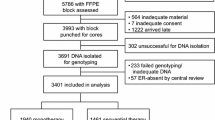Summary
We previously identified a polymorphism in the human estrogen receptor (ER) gene, within the coding region for the protein's amino terminal B-domain. In estrogen receptor-positive (ER+) breast tumors, the variant allele was preferentially associated with lower levels of ER, and was clinically correlated with frequent spontaneous abortions. DNA sequencing revealed a point mutation that changes codon 86 from Ala to Val and a silent mutation in codon 87. Because we initially detected the variant allele by analyzing RNA, only those tissues in which the ER gene is actively expressed were suitable for genotype analysis. We now describe an assay that uses genomic DNA as the substrate for determining the ER B genotype; DNA containing the polymorphic region of the ER gene is amplified by the polymerase chain reaction, then the amplified DNA is hybridized with radiolabeled oligonucleotide probes complementary to the wild type and variant ER alleles. This method allowed us to determine the ER B genotype of women with ER+ and ER− tumors, starting with minute amounts of DNA from frozen or paraffin embedded tissues. ER B genotyping was also performed on women without breast cancer using DNA extracted from blood cells. The combined results from analyses of RNA and DNA from 300 breast cancer patients showed that 12% were heterozygotes. In the ER+ group (n=183), 11.5% carried the variant gene compared to 12.8% in the ER-negative group (n=117) (χ2=0.11; df=1; p>0.25). No link to tumor histology could be established. Preliminary data on DNA from blood of healthy women over the age of 50 (n=64) yielded a slightly lower ER B-variant frequency (9.4%); this frequency was not significantly different than that in the breast cancer groups. Thus, while the variant ER allele is associated with low ER levels in ER positive breast tumors, its frequency is not different in the ER+ and ER− tumor groups and may be unrelated to breast cancer development.
Similar content being viewed by others
References
Garcia T, Lehrer S, Bloomer WD, Schachter BS: A variant estrogen receptor messenger ribonucleic acid is associated with reduced levels of estrogen binding in human mammary tumors. Mol Endocrinol 2: 785–791, 1988
Garcia T, Sanchez M, Cox JL, Shaw PS, Ross JBA, Lehrer S, Schachter BS: Identification of a variant form of the human estrogen receptor with an amino acid replacement. Nucleic Acids Res 17: 8364, 1989
Lehrer S, Sanchez M, Song HK, Dalton J, Levine E, Savoretti P, Thung SN, Schachter BS: Oestrogen receptor B-region polymorphism and spontaneous abortion in women with breast cancer. Lancet 335: 622–624, 1990
McGuire WL, Tandon AK, Allred DC, Chamness GC, Clark GM: How to use prognostic factors in axillary nodenegative breast cancer patients. J Natl Cancer Inst 82: 1006–1015, 1990
Fuqua SAW, Falette NF, McGuire WL: Sensitive detection of estrogen receptor RNA by polymerase chain reaction assay. J Natl Cancer Inst 82: 858–861, 1990
Murphy LC, Dotzlaw H: Variant estrogen receptor mRNA species detected in human breast cancer biopsy samples. Mol Endocrinol 3: 687–693, 1989
Saiki RK, Gelfand DH, Stoffel S, Scharf SJ, Higuchi R, Horn GT, Mullis KB, Erlich HA: Primer-directed enzymatic amplification of DNA with a thermostable DNA polymerase. Science 239: 487–494, 1988
Conner BJ, Reyes AA, Morin C, Itakura K, Teplitz RL, Wallace RB: Detection of Sickle Bs-globin allele by hybridization with synthetic oligonucleotides. Proc Natl Acad Sci USA 80: 278–282, 1983
Winter E, Yamamoto F, Almoguera C, Perucho M: A method to detect and characterize point mutations in transcribed genes: Amplification and overexpression of the mutant c-Ki-ras allele in human tumor cells. Proc Natl Acad Sci USA 82: 7575–7579, 1985
Wright DK, Manos MM, Innis MA, Gelfand DH, Sninsky JJ, White TJ (eds.). Sample preparations from paraffin-embedded tissues. In: PCR Protocols: A Guide to Methods and Applications. Academic Press, San Diego, 1990, pp 153–157
Ullrich A, Shine J, Chirgwin J, Pictet R, Tischer E, Rutter WJ, Goodman HM: Rat insulin genes: Construction of plasmid containing the coding sequence. Science 196: 1313–1319, 1977
Sambrook K, Fritsch EF, Maniatis T: Molecular Cloning: A Laboratory Manual. Cold Spring Harbor, New York, 1989, pp 9.31–9.45
Wood WI, Gitschier J, Lasky LA, Lawn RM: Base composition-independent hybridization in tetramethylammonium chloride: A method for oligonucleotide screening of highly complex gene libraries. Proc Natl Acad Sci USA 82: 1585–1588, 1985
Green S, Walter P, Kumar V, Krust A, Bornert JM, Argos P, Chambon P: Human oestrogen receptor cDNA sequence, expression and homology to v-erb-A. Nature 320: 134–139, 1986
Author information
Authors and Affiliations
Rights and permissions
About this article
Cite this article
Schmutzler, R.K., Sanchez, M., Lehrer, S. et al. Incidence of an estrogen receptor polymorphism in breast cancer patients. Breast Cancer Res Tr 19, 111–117 (1991). https://doi.org/10.1007/BF01980941
Issue Date:
DOI: https://doi.org/10.1007/BF01980941




